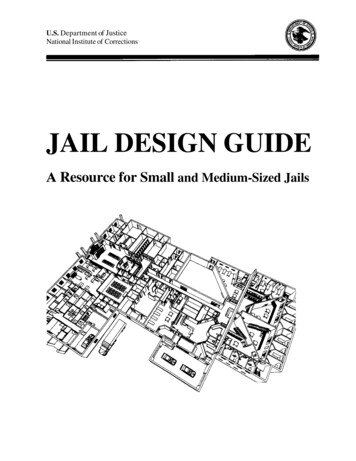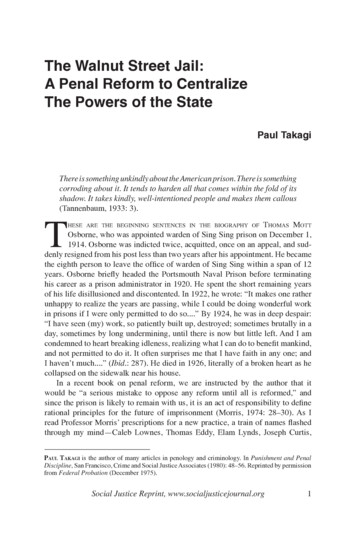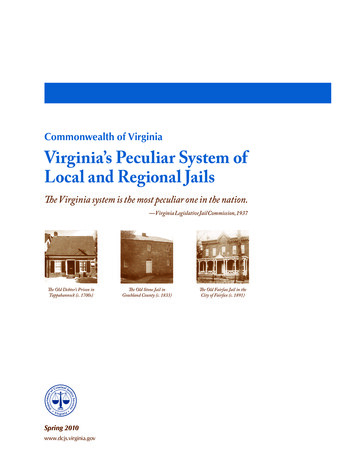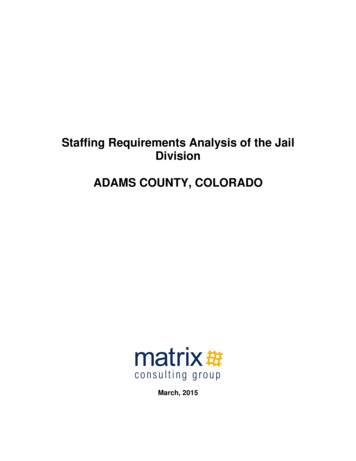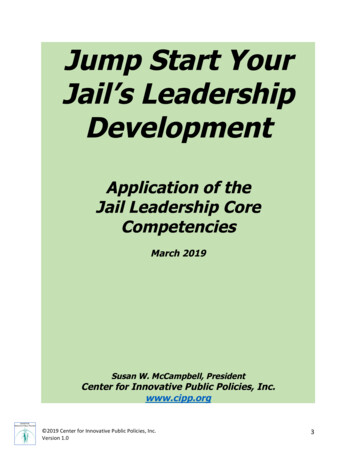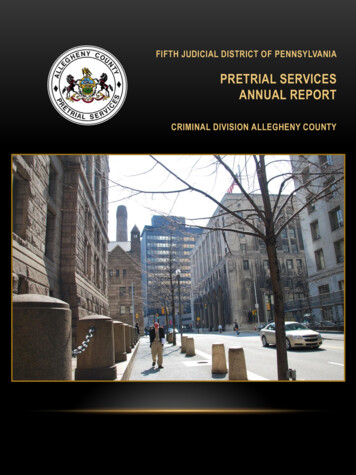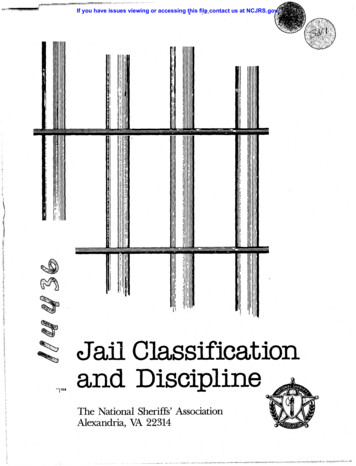
Transcription
-,/" mrv· 'l;r rr s·"'·;·;'!"),)':J''ITTIT' 'F.':I:.'n, 'i· .''':"CA,If you have issues viewing or accessing this file contact us at NCJRS.gov.j":,b.iIW4AI,,.m.Jlc\j "1''''Jail Classificationand DisciplineThe National Sheriffs' AssociationAlexandria, VA 22314
Jail ClassificationandDisciplineMarilyn B. AyresThe National Sheriffs' Association1450 Duke StreetAlexandria, VA 223141988DfCb 1988AQ.Q U1S-!TION SPublication of this handbook was supported by Grant No. GR7 from the US. Department ofJustice, NationalInstitute of Corrections. Points of view or opinions stated in this document are those of the author anddo not necessarily represent the official position or policies of the US. Department of Justice or of theNational Sheriffs' Association.I---- /. ./
,:!l- f; w·".''l'''-'n-,''"'-,c '·yv:; ''' ',, r·,··p,t' r #!A'/"AYi.SkW·".,.,.,.A h' (" L,,,.,, '1"" . , "'. "'.,','1' ",, 114436U.S. Department of JusticeNational Institute of JusticeThis document has been reproduced exactly as recei e from theperson or organization originating it. Points of view or opInions statedin this document are those of the authors and do, not nec s arllyrepresent the official position or policies of the Nalional Institute ofJustice.'Permission to reproduce this material has been i c Domain/NrCu.S. Depar-tri'iffi'f-t:o:r-.Jmrt c-eto the National Criminal Justice Reference Service (NCJRS).Further reproduction outside of the NCJRS system requires permission of the owner.Library of Congress Catalog Card Number: 88.62404Copyright 1988 The National Sheriff. ' AssociationThe National Institute of Corrections is authorized to copy and print such additional copies of thishandbook as it deems necessary or desirable. '., jf
;, 1":;'t'!!:"''"'''7-''''7-" ,, ,:, 'f;.,. .-,;"'-;r.";:; ,:, 4\4,{ t(l A4!!!!.2d!lll!!;)!!!!!!.,:A1\""',, ,;.ACTABLE OF CON'IiENTSJAIL OLASSIFIOATION AND DISOIPLINEForewordvAckrwwledgmentsVIINTRODUCTION JAIL CLASSIFICATION AND DISCIPUNE1Valid Classification, Discipline Procedures NeededAccreditation as a Goal for Today's Jails12Chapter IOVERVIEW OF JAIL CLASSIFICATION IN THE UNITED STATES5Evolution of Jail Classification in the United StatesPresent State of Jail Classification in the United States57Chapter IIGOALS AND BENEFITS OF PROPER JAIL CLASSIFICATIONDetermining, Documenting GoalsBenefits of Inmate Classification Systems9910Chapter IIIESTABLISHING THE JAIL CLASSIFICATION SYSTEM13Guidelines for Structuring a Jail Classification SystemClassification PersonnelClassification Options for Today's AdministratorsInmate Programs and ServicesThe Computer's Impact on Classification1314151619Chapter IVINTAKE AND CLASSIFICATION PROCEDURES25Admission and BookingPretrial ReleaseOrientationProtecting New Inmates' RightsEnsuring Personal SafetyClassification ProceduresInmate Accountability2527iii3030303443
f",l';:' tr; '}l'lIW lj';': : '\i;r ·".,.,."lr """""J:·' '.l ""'!;::;-"· , .o:., O'''''·''''''·' '!'·"·"'' ,-,;."' '?-." . "",,-,. - ,- ,'".-,'"." , . ', ,."'"' ",""" .,X(t L "tcj,{@11\.,.Ln)Chapter VRECLASSIFICATION PROCEDURES45Procedures for ReclassificationEmergency ReclassificationNon-Emergency Reclassification454759Chapter VIEFFECTIVE DISCIPLINE63Establishing Valid Disciplinary ProceduresDue Process and Disciplinary ProceduresDisciplinary Hearing Decision AppealsGrievances63696974APPENDIX AOBJECTIVE CLASSIFICATION-A MODEL SYSTEM77APPENDIXBCLASSIFICATION TEAM DECISION MAKING-A MODEL SYSTEM103APPENDIXCCOMPUTERIZED CLASSIFICATION-A DECISION TREE MODEL111APPENDIXDACA STANDARDS FOR ADULT LOCAL DETENTION FACILITIES-CLASSIFICATION129APPENDIXEACA STANDARDS FOR SMALL JAIL FACILITIES-CLASSIFICATION131APPENDIXFACA STANDARDS FOR ADULT LOCAL DETENTION FACILITIES- INMATE RULES AND DISCIPLINE133APPENDIXGSUICIDE PREVENTION MODEL POLICIES AND PROCEDURESADDITIONAL SOURCES137139iv
; "-ii';'; ' ;.",. . 1·':.'.'''·\''7.·'' 'V''(!·;C-\ ""·J.MU .)fS!!4;4fl*.4 ;"'"FOREWORDThe National Sheriffs' Association has prepared this handbook,Jail Classification and Discipline,with support from the US. Department ofJustice, National Institute of Corrections. The topicsof classification and discipline were previously addressed in our 1974 monograph,Jail Security,Classification and Discipline. Extensive developments in cOlTectional law and jail operations sincethat time require that these critical topics now be divided into two volumes, with security to beaddressed in the near future.Classification and discipline are major components of the correctional process, affec.ting inmatecontrol and supervision and the jail's overall orderly operation. Regardless of the jail's sizewhether it houses five inmates or 500-a properly functioning classification system has beenfound to provide for the effective management of inmates in a safe, secure correctional environ·ment, while also ensuring their eq nitable, humane treatment. In recent years, lack of standardizedclassification systems has resulted it. frequent complaints by inmates, who allege their legal rightshave been violated. As a result, courts are more and more frequently intervening in jail c1assifica·tion decisions, requiring officials to reach 'such decisions fuirly, after obtaining complete, accurateinformation. In addition, courts are requiring jails to provide opportunities for reclassificationat properly conducted hearings.Consistent, equitable discipline is also a prime requisite of any jail setting, impacting posi.tively on the behavior and personal responsibility of all inmates. By contrast, inequitable, incon·sistent, or improperly applied disciplinary procedures have long been the root of inmatedisturbances and grievances. Today, jail disciplinary procedures are subject to review by rulesinfractions committees or disciplinary hearing boards. The actions of these boards can resultin loss of good time or certain privileges for tlle inmate; therefore, they often result in controversyas well as scrutiny by the courts.Because both classification and discipline are subject to frequent criticism by inmates andexamination by the courts, administrators must establish clear, workable policies and proceduresin these areas, remaining alert to current and forthcoming cases, developing standards, and evolvingcorrectional law.The purpose of this handbook is to assist the administrator in establishing such policies andprocedures anclmeeting the objectives of classification and discipline within the framework ofapplicable standards and state and local codes.L. Cary BittickExecutive DirectorNational Sheriffs' Associationv
,.' ",,:·t"' n:';:',·T-:'.':V;'1 1''1) '''I '''''''' ''.'''' '';'':'''--"''',·:V:"\,.·;- ;; ",·), ,·-"\","·""· ;,··.,,-,,,,. ,,lII/I!Ii""#!!II!3 DGMH;NTSThis publication was made possible through the combined efforts of a number of individualswho donated their time and expertise during its development. We are particularly grateful toour advisory board:Sheriff Fred Pearce, ChairmanMultnomah County, ORJames AustinDirector of ResearchThe National Council on Crime andDelinquencySan Francisco, CASheriff James A. GondlesArlington County, VAJack GreenMministrator, Standards and AccreditationAmerican Correctional AssociationCollege Park, MDSheriff M. Wayne HugginsFairfax County, VAMichael O'TooleChief, Jails DivisionNational Institute of Corrections JailCenterBoulder, COChief Deputy Carl PeedFairfax County Sheriffs OfficeFairfax, VASheriff Bob RicePolk County, IASheriff Robert RufoSuffolk County, MASheriff James A. TelbLucas County, OHSpecial appreciation is also extended to the following persons, whose critical reading of the draftchapters and invaluable recommendations contributed significantly to Jail Classij"zcation andDiscipline:Bill DelaneyCorrections AdministratorLucas County Sheriffs OfficeToledo,OHGary SimmoMsClassification SupervisorMultnomah County Detention CenterPortland, ORSteve KovaksDiagnostic and Treatment BranchFairfax County Sheriffs OfficeFairfax, VALois VenturaDirector of Inmate SeryicesLucas County Sheriffs OfficeToledo,OHLarry ReillyRestitution SupervisorMultnomah County Detention CenterPortland, ORMichael G. WetherbyHearings OfficerMultnomah County Detention CenterPortland, ORMarvin WilsonAssistant Chief JailerPolk County Sheriffs OfficeDes Moines, IAvi
1.,\':"rfr;:}"'\''''' ''':l';. .-, '"r.,.,'J":,'",". w :li""P"l'!!#b""' ;i,!!!!,JPIIIII!)UIIIII!-': )!!'!?)IIIII!. , I!!f."We are also grateful for the contributions of Vince McEvoy and the Prince George's County(MD) Department of Corrections; Daniel McCarthy, the National Council on Crime and Delinquency, San Francisco, CA; the National Institute of Corrections Jail Information Center, Boulder, CO; Emmett A. Rathbun ill, Federal Bureau of Investigation National Crime InformationCenter, Washington, ne.; and Judith E Cox, Assistant Director, Bureau of Forensic Services, NewYork State Office of Mental Health, Albany, NY.Credit for consistent direction throughout the text development belongs to NSA ExecutiveDirector L. Cary Bittick and Assistant Executive Director Thomas Finn; to Anna laszlo for herguidance and valuable insight; and to Walter Bacak, Theresa Seemiller,Jackie White, and SusanBowsky fo::- their assistance in producing and finalizing the manuscript.Finally, appreciation is extended to NIC project monitor Michelle Borg.vii
J. r.!'HiijiAj"! ,'ti ,l I;W,jh,!§t . , '-\.?,ij,).h.,L"?V'."i(j!i·.·".· R·dj'·c"-"',.,L."0\""'.,,""",,-:,-,,'"'",, 117 l'."W X"",4,.!'!!'!,!ll'IJ, '1!!!!!g;; l·, 'Y'll!l!k1INTRODUOTIONJail Classificationand Disciplinetionists . murderers to check bouncers-persons withvastly differing criminal backgrounds, emotional makeup,needs, skills, and educational levels are forced into thesame jail population, requiring equally differing security,custody, and treatment approaches.Classification, or the evaluative process by which housing decisions are made, is the primary management toolto aid in providing appropriate responses to this widelydiverse inmate population. Classification determines thedegree of supervision required to control each inmateto maintain the safety and security of the institution andthe community. It also provides a diagnostic process bywhich newly admitted inmates' educational, social, medical, and psychological needs can be identified:Overall, a properly functioning classification systemhas been found to provide the basis for the effectivemanagement of inmates in a safe, secure correctionalenvironment, while also ensuring their equitable, humane treatment.Classification Shotild be an ongoing process that reoccurs on a regularly scheduled or an as needed basis during the inmates' incarceration. Since an inmate's classification affects every facet of the normal routine, he or sheis entitled to certain procedural safeguards prior to bothinitial and reclassification actions. It is essential that deci·sions not be made capriciously or arbitrarily; and manyjails have been reprimanded by the courts for failing toprovide an adequate or equitable classification system.As the chief officer of the local detention facility or jail,today's jail administrator performs a critical, difficult rolein American society. Not only are administrators andtheir jails under seemingly constant attack from critics,but also, with increasing frequency, inmates in ournation's correctional facilities are questioning the con·ditions of their confinement, particularly in the areas ofhousing, programs, and disciplinary procedures.In many instances, especially during the past twodecades, courts have found it necessary to intervene onthese issues and render decisions that impact significantlyupon jail operations. Successful challenges against jailconditions or policies have resulted in substantial finan·cial hardships, with many state and local corrections officials and jurisdictions now facing judgments in the thousands of dollars} Liability insurance is costly and difficultto obtain, and administrators must take a proactive stanceto avoid unnecessary litigation.In the past, jail administrators were free to conducttheir operations with little or no regard for developmentsin correctional law. Today, these officials must take stepsto gain insight into judicial developments in all areas ofcorrections. It is essential that they stay abreast of existing as well as changing laws and that they follow the fed·eral cases pertaining to corrections.VALID CLASSIFICATION, DISCIPLINEPROCEDURES NEEDEDTwo goals of any jail administration should be to: 1)protect inmates' rights; and 2) reduce the potentialliability of the administrator. Progress toward the first ofthese objectives promotes the success of the second. Inattempting to reach the first objective, and as an aid topreventing, rather than defending lawsuits,jail administrators in recent years have begun to focus on developingand implementing valid, equitable classification systemsand establishing appropriate, consistent disciplinaryprocedures based on equitable standards.Early Court Rulings. As far back as 1970, in Morris v.Tmvisono, a Rhode Island district court initiated rules forcorrections officials to follow in making classificationdecisions. Among the rules it suggested were: A review of certain inmates' classifications every 90days; Automatic review of those in the lowest classificationevery 30 days; The right of inmates to appear at classificationhearings; The right ofinmates to challenge unfavorable reportsaffecting their classifications; The recording of all classification proceedings.sClassification: An Essential Management ToolAll jails, regardless of size, are required to deal with widelydiverse elements of society. Armed robbers to exhibi-1
'\1!7'J ;J.f!\r, 


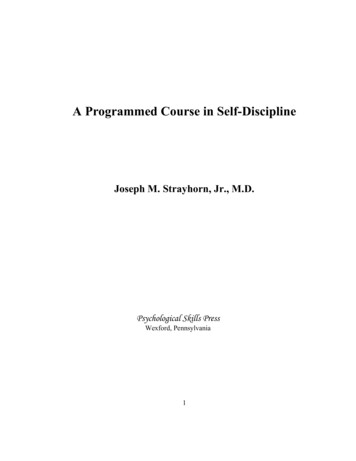
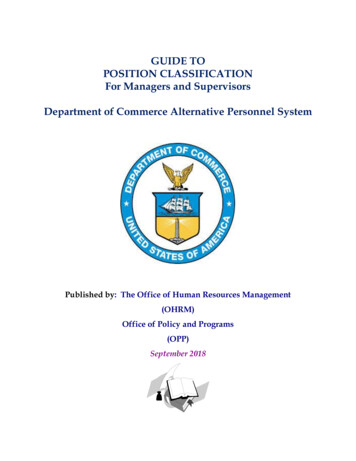
![Letter from Birmingham Jail (1963) [Abridged]](/img/2/1963-mlk-letter-abridged.jpg)
